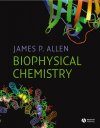![Biophysical Chemistry Biophysical Chemistry]()
Click to have a closer look
About this book
Contents
Customer reviews
Biography
Related titles
About this book
This text presents physical chemistry through the use of biological and biochemical topics, examples and applications to biochemistry. It lays out the necessary calculus in a step by step fashion for students who are less mathematically inclined, leading them through fundamental concepts, such as a quantum mechanical description of the hydrogen atom rather than simply stating outcomes. Techniques are presented with an emphasis on learning by analyzing real data.
Contents
Preface0. Basic thermodynamic and biochemical concepts 0.1 Fundamental thermodynamic conceptsStates of matterPressureTemperatureVolume, mass, and number0.2 Properties of gasesThe ideal gas laws Gas Mixtures0.3 Kinetic energy of gases 0.4 Real Gases Liquifying gases for low temperature spectroscopy0.5 Molecular Basis for LifeCell MembranesAmino acidsClassification of amino acids by their side chainsDNA and RNA1. First law of thermodynamicsSystemsState FunctionsFirst law of thermodynamics 1.1 Research Direction: Drug design I WorkSpecific heat Internal energy for an ideal gasEnthalpyDependence of specific heat on enthalpyDerivative box: State Functions described using partial derivativesEnthalpy changes of biochemical reactions 1.2 Research Direction: Global climate change2. Second law of thermodynamicsEntropyEntropy changes for reversible and irreversible processes The second law of thermodynamicsInterpretation of entropyThird law of thermodynamicsGibbs energyRelationship between the Gibbs free energy and the equilibrium constant2.1 Research Direction: Drug design IIGibbs free energy for an ideal gasUsing the Gibbs free energyCarnot cycle and hybrid carsDerivative box: Entropy as a state function2.2 Research Direction: Nitrogen fixation 3. Phase diagrams, mixtures and chemical potentialSubstances may exist in different phasesPhase diagrams and transitionsChemical potentialProperties of lipids described using the chemical potential3.1 Research Direction: lipid raftsDetermination of micelle formation using surface tension MixturesRaoult's law Osmosis3.2 Research Direction: Protein crystallization4. Equilibria and reactions involving protonsGibbs free energy minimumDerivative box:Relationship between the Gibbs energy and equilibrium constantResponse of the equilibrium constant to condition changesAcid-base equilibriaProtonation states of amino acid residuesBuffersBuffering in the cardiovascular system4.1 Research Direction: Proton coupled electron transfer and pathways5. Oxidation/reduction reactions and bioenergetics Oxidation/reduction reactions Electrochemical cellsThe Nernst Equation: Midpoint potentialsGibbs energy of formation and activityIonic strengthAdenosine triphosphate,ATPChemiosmotic hypothesis5.1 Research Direction: Respiratory chain5.2 Research Direction: ATP synthase6. Kinetics and enzymesThe rate of a chemical reaction. Parallel first-order reactionsSequential first order reactionsSecond-order reactionsThe order of a reactionReactions that approach equilibriumActivation energy6.1 Research Direction: Electron transfer I: EnergeticsDerivative box Derivation of Marcus relationshipEnzymesEnzymes lower the activation energyEnzyme mechanisms6.2 Research Directions: Dynamics in enzyme mechanismMichaelis-Menten mechanismLineweaver-Burk equationEnzyme activity6.3 Research direction: The RNA world7. The Boltzmann distribution and statistical thermodynamicsProbabilityBoltzmann distributionPartition functionStatistical thermodynamics7.1 Research Direction: Protein folding and prionsPrions8. Quantum theory: Introduction and principlesClassical conceptsExperimental failures of classical physicsBlackbody radiationPhotoelectric effectAtomic spectraPrinciples of quantum theoryWave Particle DualitySchrodinger's EquationBorn InterpretationGeneral approach for solving Schrodinger's equationInterpretation of quantum mechanicsHeisenberg Uncertainty PrincipleA quantum mechanical world8.1 Research Direction: Schrodinger's cat 9. Particle in box and tunnelingOne-dimensional particle in the boxProperties of the solutionsEnergy and wavefunctionSymmetryWavelengthProbabilityAverage or expectation valueTransitions9.1 Research Direction: CarotenoidsTwo-dimensional particle in a boxTunneling9.2 Research Direction: Probing biological membranes9.3 Research Direction: Electron transfer II: Distance dependence10. Vibrational motion and infrared spectroscopySimple Harmonic Oscillator: Classical theoryPotential energy for the simple harmonic oscillatorSimple Harmonic Oscillator: Quantum theoryDerivative box: Solving Schrodinger's equation for the simple harmonic oscillatorProperties of the wavefunctionsEnergy and wavefunctionForbidden regionTransitionsVibrational Spectra10.1Research Direction: Hydrogenase11. Atomic structure: Hydrogen atom and Multi-electron atomsSchrodinger's equation for the hydrogen atomDerivative box: Solving Schrodinger's equation for the hydrogen Separation of variablesAngular SolutionRadial solutionProperties of the general solutionAngular MomentumOrbitalss-orbitalsp-orbitalsd-orbitalsTransitions11.1 Research Direction: Hydrogen economySpinDerivative box:Relativistic equationsMany electron atomsEmpirical constantsSelf-consistent field theory (Hartree-Fock)Helium atomSpin-orbital couplingPeriodic table12. Chemical bonds and protein interactionsSchrodingers' equation for the hydrogen moleculeValence bondsHuckel modelInteractions in proteinsPeptide bondsSteric effectsHydrogen bondsElectrostatic interactionsHydrophobic effectsSecondary structureDetermination of secondary structure using circular dichroism12.1 Research Direction: Modeling protein structures13. Electronic Transitions and optical spectroscopyThe nature of lightThe Beer-Lambert lawMeasuring absorptionTransitionsDerivation box: Relationship between the Einstein coefficient LasersSelection RulesFranck Condon PrincipleThe Relationship Between Emission and Absorption SpectraThe yield of fluorescence Fluorescence Resonance Energy Transfer: FRETMeasuring fluorescencePhosphorescence13.1 Research Direction: Probing Energy transfer using 2D optical spectroscopy13.2 Research Direction: Single molecule spectroscopyHolliday junctions14. X-ray diffraction and EXAFSDiffraction theoryBragg's LawBravais latticesProtein crystalsDiffraction from CrystalsDerivative box: Phases of complex numbersPhase determination Molecular ReplacementIsomorphous Replacement Anomalous DispersionModel BuildingExperimental measurement of X-ray diffractionExamples of protein structures14.1 Research Direction: NitrogenaseEXAFS15. Magnetic resonance Nuclear magnetic resonanceChemical shiftsSpin-spin interactionsPulse techniquesTwo dimensional NMR:Nuclear Overhauser effectNMR spectra of amino acids15.1 Research Direction: Development of new NMR techniques15.2 Research Direction: Spinal Muscular AtrophyMagnetic Resonance Imaging (MRI)Electron Spin ResonanceHyperfine structureSpin probesENDOR15.3 Research Direction: heme proteins 15.4 Research Direction: ribonucleotide reductase16. Signal transductionBiochemical pathway for visual responseSpectroscopic studies of rhodopsinBacteriorhodopsinStructural studiesComparison of rhodopsins from different organismsRhodopsin proteins in visual response17. Membrane potentials, transporters, and channelsMembrane potentialsEnergetics of transport across membranesTransportersIon channels18. Molecular imagingGreen fluorescent protein,GFPMechanism of chromophore formationFRET: fluorescence resonance energy transferImaging of GFP in cellsImaging in organismsRadioactive decayPositron emission tomographyParkinson's disease19. PhotosynthesisEnergy transfer and light-harvesting complexesElectron transfer, bacterial reaction centers, and photosystem IWater oxidation
Customer Reviews
Biography
James Allen is a professor at Arizona State University. He has won numerous honors including several study sections with the National Institutes for Health and was selected for Who's Who Among America's Teachers.


































